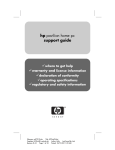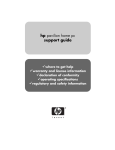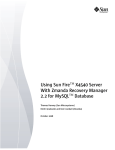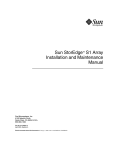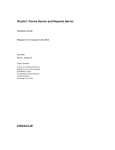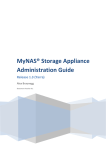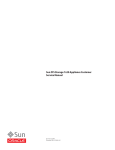Download Sun Microsystems X4500 User's Manual
Transcript
Sun Fire X4500 as a Symantec Netbackup 6.5 Media Server A Quick Start Guide Sun Microsystems December 11, 2007 2007 Sun Microsystems, Inc., 4150 Network Circle, Santa Clara, CA 95054 USA All rights reserved. This product or document is protected by copyright and distributed under licenses restricting its use, copying, distribution, and decompilation. No part of this product or document may be reproduced in any form by any means without prior written authorization of Sun and its licensors, if any. Third-party software, including font technology, is copyrighted and licensed from Sun suppliers. Parts of the product may be derived from Berkeley BSD appliances, licensed from the University of California. Sun, Sun Microsystems, Solaris, Sun StorageTek, Sun StorEdge, and the Sun logo are trademarks, registered trademarks, or service marks of Sun Microsystems, Inc. in the U.S. and other countries. UNIX is a registered trademark in the United States and other countries, exclusively licensed through X/Open Company, Ltd. Windows is a registered trademark of Microsoft Corporation in the United States and other countries. All SPARC trademarks are used under license and are trademarks or registered trademarks of SPARC International, Inc. in the U.S. and other countries. Products bearing SPARC trademarks are based upon an architecture developed by Sun Microsystems, Inc. The OPEN LOOK and Sun's Graphical User Interface was developed by Sun Microsystems, Inc. for its users and licensees. Sun acknowledges the pioneering efforts of Xerox in researching and developing the concept of visual or graphical user interfaces for the computer industry. Sun holds a non-exclusive license from Xerox to the Xerox Graphical User Interface, which license also covers Sun's licensees who implement OPEN LOOK GUIs and otherwise comply with Sun's written license agreements. RESTRICTED RIGHTS: Use, duplication, or disclosure by the U.S. Government is subject to restrictions of FAR 52.227-14(g)(2)(6/87) and FAR 52.227-1987), or DFAR 252.227-7015(b)(6/95) and DFAR 227.7202-3(a). DOCUMENTATION IS PROVIDED ÒAS ISÓ AND ALL EXPRESS OR IMPLIED CONDITIONS, REPRESENTATIONS AND WARRANTIES, INCLUDING ANY IMPLIED WARRANTY OF MERCHANTABILITY, FITNESS FOR A PARTICULAR PURPOSE OR NON-INFRINGEMENT, ARE DISCLAIMED, EXCEPT TO THE EXTENT THAT SUCH DISCLAIMERS HELD TO BE LEGALLY INVALID. Sun Microsystems, Inc. Table of Contents Introduction.....................................................................................................................................................3 Configuration .................................................................................................................................................. 4 Overview............................................................................................................................................................... 4 Solaris Configuration.............................................................................................................................................. 5 Zpool Configuration................................................................................................................................................ 5 ZFS Configuration................................................................................................................................................... 6 Netbackup Configuration....................................................................................................................................... 7 Frequently Asked Questions............................................................................................................................. 16 Summary....................................................................................................................................................... 18 References..................................................................................................................................................... 19 3 Introduction Sun Microsystems, Inc. Introduction The Sun Fire(TM) X4500 server delivers massive storage capacity and remarkable throughput making it an ideal nearline storage platform for backup and restore applications. Combining the power of the Solaris 10 Operating System with the data integrity and simplified administration of ZFS, the X4500 becomes an ideal candidate for streamlining and improving backup/restore operations. This paper discusses how to quickly configure the X4500 as a Media Server for Symantec Veritas NetBackup. 4 Configuration Sun Microsystems, Inc. Configuration Overview The below diagram shows an example NBU configuration with the X4500 acting as a Media Server. The default NIC configuration on the X4500 allows up to four physical GigaBit Ethernet connections to be attached. The four connections can be utilized to back up four separate subnets, or the links can be aggregated together using dladm(1M) for improved throughput to a single subnet. Netbackup Master Server X4500 Netbackup Media Server Arc hiv e Im ag eD up lica tion Optional Tape Library for Archiving and Long Term or Offsite Storage The X4500 can also be connected to an optional Tape Library (using FibreChannel or SCSI connections) for Image Duplication or Archiving purposes. The X4500 can also be used as the primary data cache for Staging operations, with a Tape Library be utilized for longer term storage and data moved to tape after certain filesystem utilization or timebased thresholds are reached. It is also possible that the Tape Library is attached to a completely separate Media Server. 5 Configuration Sun Microsystems, Inc. Solaris Configuration The X4500 server used while testing for this paper was installed with Solaris 10 8/07. This is the recommended version to use with Netbackup as various ZFS improvements were introduced in this build. The X4500 has 48 500GB SATA drives. The two boot drives (c5t0d0 and c5t4d0) are mirrored using Solaris Volume Manager. The rest of the drives are available for backup data. Zpool Configuration Zpool configuration is a decision that needs to be made based on a number of factors. • • • What is the required performance needed? (IOPS/Throughput) What is the required data protection level needed? (RAIDZ/RAIDZ2/Mirror) What is the required capacity? After gathering and analyzing the requirements, a configuration that balances the needs of those requirements can be chosen. When configuring the system for network backups, the ability of the X4500 to receive data over the network is also a factor. For example, a 450MB/s backup speed requirement cannot be met solely by using the 4 onboard Gigabit Network ports. Additional network cards would be needed to meet this requirement. Care should be taken that a system is not over configured for disk performance, at the expense of space or data protection, when the entire system (encompassing backup clients and network infrastructure) is not able to send data at adequate levels. Likewise, a system should not be over configured for space at the expense of performance or data protection. For the purposes of this Quick Start Guide, the X4500 was configured one zpool consisting of 8 x 5 disk RAIDZ vdevs. Additionally, 6 hotspares were configured for reliability. This gives the X4500 sufficient disk performance to handle 300350MB/sec of backup traffic over the network. Example Zpool creation script: #!/bin/bash zpool create -f nbupool raidz c0t0d0 c1t0d0 c4t0d0 c6t0d0 c7t0d0 \ raidz c0t1d0 c1t1d0 c4t1d0 c5t1d0 c7t1d0 \ raidz c0t2d0 c1t2d0 c5t2d0 c6t2d0 c7t2d0 \ raidz c0t3d0 c1t3d0 c4t3d0 c6t3d0 c7t3d0 \ raidz c0t4d0 c1t4d0 c4t4d0 c6t4d0 c7t4d0 \ raidz c0t5d0 c4t5d0 c5t5d0 c6t5d0 c7t5d0 \ raidz c0t6d0 c1t6d0 c4t6d0 c5t6d0 c6t6d0 \ raidz c1t7d0 c4t7d0 c5t7d0 c6t7d0 c7t7d0 \ spare c6t1d0 c5t3d0 c4t2d0 c1t5d0 c7t6d0 c0t7d0 6 Configuration root@thumper1 # zpool list NAME SIZE USED AVAIL CAP HEALTH nbupool 18.1T 58.6G 18.1T 0% ONLINE Sun Microsystems, Inc. ALTROOT - The size listed in the above command is the actual physical space in the pool. This may differ from the actual space data may occupy as various RAIDZ methods and configurations are not taken into account. See the zpool(1M) man page for more details. ZFS Configuration In this example, the X4500 Media Server is configured to write to Basic Disk Storage Units. Each Storage Unit is created from a ZFS filesystem mountpoint. The number of filesystems needed will be a implementation by implementation decision but a few factors should be considered. • • • Number of Backup/Recover streams needed Number of duplication or stage operations needed Number of Tape Drives configured for duplication or stage operations In this example, 4 backup filesystems are created (/backup1, /backup2, /backup3, /backup4). Testing has shown that creating a single ZFS filesystem for all backup streams is a bottleneck that limits the throughput to 200-250MB/sec. Using multiple filesystems in parallel eliminates that bottleneck. Example ZFS filesytem creation script: #!/bin/bash for fs in 1 2 3 4 do zfs create -o mountpoint=/backup$fs nbupool/backup$fs done root@thumper1 # zfs list NAME USED AVAIL REFER MOUNTPOINT nbupool 46.8G 14.2T 39.1K /nbupool nbupool/backup1 14.8G 14.2T 14.8G /backup1 nbupool/backup2 10.8G 14.2T 10.8G /backup2 nbupool/backup3 5.38G 14.2T 5.38G /backup3 nbupool/backup4 15.8G 14.2T 15.8G /backup4 7 Configuration Sun Microsystems, Inc. Netbackup Configuration The X4500 will be configured as a Media Server. In this example, it is assumed that there is a separate Master NBU server. The Netbackup and Media Manager package must be installed on the X4500. It also will require the appropriate server licensing. It is recommended that the Master server's bp.conf file be updated with the new Media server information before installing the software on the media server. An example is shown below. The supported installation method is using the install script that comes with the Netbackup Installation media. root@thumper1 # /nfs/nbu-new/DVD2/install Symantec Installation Script Copyright 1993 - 2007 Symantec Corporation, All Rights Reserved. Installing NetBackup Server Software NOTE: To install only NetBackup Client software locally on this machine or to load additional UNIX client software on this server, insert the NetBackup UNIX Clients cdrom. Do you wish to continue? [y,n] (y) y NetBackup installs to the running root environment, by default. Are you installing to the running root environment? [y,n] (y) y Processing package instance <SYMCnetbp> from </nfs/nbu-new/DVD2/solaris_x86> (... rest of the installation output omitted for brevity...) After the installation process prompts for the license key and the key is properly entered, the following questions need to be answered Would you like to use "thumper1" as the configured name of the NetBackup server? [y,n] (y) y Is thumper1 the master server? [y,n] (y) n What is the fully qualified name of the master server? sol-230 The previously installed master server name should be entered. In this example, the master server name was sol-230. After the package is installed on the X4500. The Master Server EMM database must be updated with the new Media Server information. From the Master Server command line: # /usr/openv/netbackup/bin/admincmd/nbemmcmd -addhost -machinename thumper1 -machinetype media -masterserver sol-230 \ -netbackupversion 6.5 -operatingsystem solaris NBEMMCMD, Version:6.5 Command completed successfully. 8 Configuration Sun Microsystems, Inc. Where machinename is the name of the X4500 and masterserver is the name of the Master Server. The results of this command can be verified # nbemmcmd -listhost NBEMMCMD, Version:6.5 The following hosts were found: media thumper1 master sol-230 server sol-230 Command completed successfully. The bp.conf files on both Master and Media servers and any clients should be adjusted for the new Media Server. On the Master Server SERVER = sol-230 SERVER = thumper1 CLIENT_NAME = sol-230 EMMSERVER = sol-230 VXDBMS_NB_DATA = /usr/openv/db/data On the Media Server SERVER = sol-230 SERVER = thumper1 CLIENT_NAME = thumper1 EMMSERVER = sol-230 Also, any client needing access to the Media Server resources should add SERVER=<x4500 name> into it's bp.conf file as well. Restart the NetBackup processes on the Master and Media servers to have the changes recognized. 9 Configuration Sun Microsystems, Inc. Use the NetBackup GUI for the remaining configuration Verify that the Media Server is recognized via Host Properties -> Media Servers Click on the X4500 hostname to ensure the Media Server is Connected The Master Server will already be listed. 10 To create a Storage Unit using the ZFS filesystems previously configured, follow the below procedures Storage -> Storage Units Right-Click to add new Storage Unit Sun Microsystems, Inc. 11 Storage Unit Configuration • Use Basic Disk as the Type • Ensure the Media Server is the X4500 • Set the Absolute pathname to one of the ZFS filesystems Sun Microsystems, Inc. 12 Follow the same procedures for the rest of the ZFS filesystems you have configured. Sun Microsystems, Inc. 13 Sun Microsystems, Inc. The individual Storage Units could then be used as backup destinations, however, configuring Storage Groups can prove beneficial. Add a New Storage Group 14 Sun Microsystems, Inc. Add the Storage Units that have been created into a Storage Group. The Storage Unit Selection will be Round-Robin. This will ensure that backup streams are allocated across all units. 15 Sun Microsystems, Inc. Once the Storage Group is configured, the Policy Attributes for the backup jobs can be configured to use the Storage Group as the Policy Storage. 16 Frequently Asked Questions Sun Microsystems, Inc. Frequently Asked Questions Q1: How does the X4500 scale as the workload increases? A1: Testing was done to measure scalability by saturating each onboard GigE port in turn. Three Zpool configurations were tested. The RAIDZ1-6Spares (14.3TB of usuable space) configuration is the configuration listed in the example earlier in this guide. The RAIDZ1-NoSpares (16.9TB of usuable space) configuration is based on the default Zpool configuration pre-installed at the factory. The Mirror-NoSpares (10.3TB of usable space) configuration is a Single Zpool consisting of 22 mirrored pairs. Sufficient client load was generated to ensure each GigE interface could be fully saturated at 1 Gigabit per sec. The test data consisted of 32 GB of large files on each client. As shown in the graph below, the X4500 can deliver close to 350 MB/sec using the 4 onboard GigE ports. Also, the testing shows that at these data rates Zpool configuration is not a driving factor for performance. The network/CPU load becomes the bottleneck before the Zpool. X4500 NBU Scalability 400 350 300 MB/Sec 250 RAIDZ1-6Spares 200 RAIDZ1-NoSpares Mirror-NoSpares 150 100 50 0 1 2 3 GigE Ports Q2: Has the configuration been tested with 10GB Ethernet? 4 17 Frequently Asked Questions Sun Microsystems, Inc. A2: Yes. A Proof-of-Concept was done for a large customer and 10GB Ethernet was part of the testing. Using a Neterion Xframe II and the xge driver, 8 clients capable of delivering 100MB/sec each were configured to backup to a X4500. Jumbo Frames were enabled on all components. Throughput rates of 500-550 MB/sec were achieved using the Zpool/ZFS configurations mentioned above. Image duplication between two X4500 Media Servers was measured at 350 MB/sec. Q3. How can I achieve even higher aggregate backup speeds? A4. By configuring additional X4500 Media Servers and placing all the Disk Storage Units from all Media Servers into a single Storage Unit Group, Netbackup can effectively round-robin across multiple X4500s for even higher aggregate throughput rates. 18 Summary Sun Microsystems, Inc. Summary This guide was a Quick Start introduction into configuring the Sun Fire X4500 as a disk-cache Media Server for Veritas Netbackup 6.5. It gave examples on configuring the zpool and zfs filesystems on Solaris and how to configuration the Netbackup application to utilize the X4500. Using this guide, backup throughput rates of over 1TB per hour are achievable. 19 References Sun Microsystems, Inc. References i. Veritas Netbackup 6.5 Documentation 1. http://seer.entsupport.symantec.com/search_forms/doc_list.asp?DocType=Comp&C LSUB=NBUESVRSUB11682&MSUB=NBUESVRSUB11686&SearchArea=ALL&el=%2C+1& ddProduct=NBUESVR&pid=&width=&SearchTerm=&subject=NBUESVRSUB11686&Pro ductVersion=NBUESVRPVER24910&language=English ii. Sun Fire X4500 Document Collection 1. http://www.sun.com/products-nsolutions/hardware/docs/Servers/x64_servers/x4500/index.html iii. Solaris 10 System Administrator Collection 1. ZFS Admin Guide - http://docs.sun.com/app/docs/doc/819-5461 2. IP Services Guide - http://docs.sun.com/app/docs/doc/816-4554 iv. Solaris Internals Website 1. ZFS Best Practices Guide http://www.solarisinternals.com/wiki/index.php/ZFS_Best_Practices_Guide





















